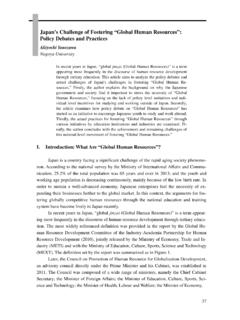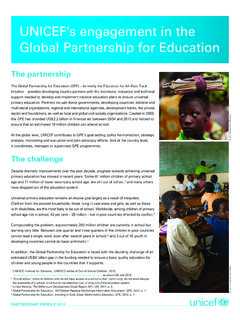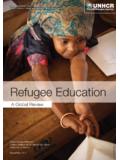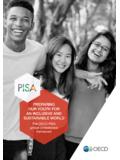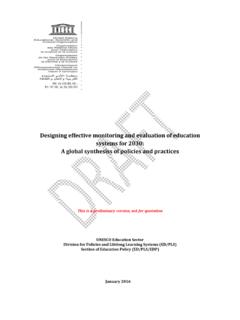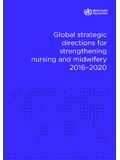Transcription of Global standards for the initial education of …
1 Nursing & Midwifery Human Resources for Health Global standards for the initial education of professional nurses and midwives Global standards for the initial education of professional nurses and midwives (WHO/HRH/ ). This publication was produced by the Department of Human Resources for Health, World Health Organization. This publication is available on the Internet at: Copies may be requested from: World Health Organization, Department of Human Resources for Health, CH-1211 Geneva 27, Switzerland World Health Organization 2009. All rights reserved. Publications of the World Health Organization can be obtained from WHO Press, World Health Organization, 20 Avenue Appia, 1211 Geneva 27, Switzerland (tel: +41 22 791 3264.)
2 Fax: +41 22 791 4857; email: Requests for permission to reproduce or translate WHO publications whether for sale or for noncommercial distribution should be addressed to WHO. Press, at the above address (fax: +41 22 791 4806; email: The designations employed and the presentation of the material in this publication do not imply the expression of any opinion whatsoever on the part of the World Health Organization concerning the legal status of any country, territory, city or area or of its authorities, or concerning the delimitation of its frontiers or boundaries. Dotted lines on maps represent approximate border lines for which there may not yet be full agreement. The mention of specific companies or of certain manufacturers' products does not imply that they are endorsed or recommended by the World Health Organization in preference to others of a similar nature that are not mentioned.)
3 Errors and omissions excepted, the names of proprietary products are distinguished by initial capital letters. All reasonable precautions have been taken by the World Health Organization to verify the information contained in this publication. However, the published material is being distributed without warranty of any kind, either expressed or implied. The responsibility for the interpretation and use of the material lies with the reader. In no event shall the World Health Organization be liable for damages arising from its use. This publication contains the collective views of an international group of experts and does not necessarily represent the decisions or the stated policy of the World Health Organization.
4 Edited by: Elizabeth Girardet, Freelance Editor, Geneva, Switzerland. Design & layout by: (cover illustration Eric Scheurer). Nursing & Midwifery Human Resources for Health Global standards for the initial education of professional nurses and midwives Geneva 2009. Contents Acknowledgements 4. Part one 7. Background 8. Goal of the Global standards 10. Intended use of standards 12. The context 14. Process and methodology 16. Part two 18. standards for nursing and midwifery initial education 19. Principles 19. Programme graduates 20. Programme development/revision 22. Programme curriculum 24. Faculty 26. Programme admission 28. Part three 30. References 31. Annex: List of respondents 32.
5 Glossary 35. 3. Acknowledgements The World Health Organization (WHO) gratefully acknowledges the ex- pertise, time and contributions of all those who engaged in the develop- ment of these Global standards , enriching the procedure with their collec- tive wisdom, intellectual input and the shared experience of their diverse organizations. WHO is particularly grateful to the members of the Task Force on Global standards in Nursing and Midwifery education who contributed their exper- tise and resources over countless hours and worked with vision and com- mitment to bring this initiative to completion: Dr Fariba Al-Darazi (WHO. Regional Office for the Eastern Mediterranean), Dr Sawsan Al-Majali (Nurs- ing Programme, Dar Al-Hekma College), Ms Nancy Dickenson-Hazard (Sigma Theta Tau International), Dr Valerie Fleming (Glasgow Caledo- nian University, WHO Collaborating Centre for Nursing and Midwifery), Dr Karen Morin (University of Wisconsin, Milwaukee), and Dr Jean Yan (World Health Organization).
6 WHO also extends sincere appreciation to the individuals and organizations that participated in the following meetings. Developing Global standards for initial Nursing and Midwifery Educa- tion, Bangkok, Thailand, December 2006: Dr Sawsan Al-Majali (The Global Advisory Group for Nursing and Mid- wifery Advisers for Nursing and Midwifery), Dr Jean E. Bartels (Ameri- can Association of Colleges of Nursing), Mr David C. Benton (International Council of Nurses), Dr John Daly (Council of Deans of Nursing and Mid- wifery, Australia and New Zealand), Ms Nancy Dickenson-Hazard (Sigma Theta Tau International), Dr Majeda Mohammed El-Bana (Scientific Asso- ciation of Arab Nursing Faculties), Dr Valerie Fleming (WHO Collaborat- ing Centre for Nursing and Midwifery Development, Glasgow Caledonian University), Dr Kathleen Fritsch (WHO Regional Office for Western Pa- cific), Ms Andrea E.
7 Higham (Johnson and Johnson), Ms Anne Hyre (Johns Hopkins Program for International education in Gynecology and Obstet- rics), Ms Lennie Adeline Kamwendo (Association of Malawian Midwives), Dr Shak Ketefian (International Network for Doctoral education in Nurs- ing), Dr Siriporn Khampalikit (Thammasat University, Faculty of Nursing), 4 Global standards for the initial education of professional nurses and midwives Dr Wipada Kunaviktikul (WHO Collaborating Centre for Nursing and Mid- wifery, Chiang Mai University), Dr Lynnette Leeseberg Stamler (Canadian Association of Schools of Nursing), Mrs Mar a Paz Mompart Garc a (Asoci- aci n Latino Americana de Escuelas y Facultades de Enfermer a), Dr Karen Morin (Sigma Theta Tau International), Dr Barbara L.
8 Nichols (Commission on Graduates of Foreign Nursing Schools), Dr Kobkul Phancharoenworakul (WHO Collaborating Centre for Nursing and Midwifery Development, Fac- ulty of Nursing, Mahidol University), Dr Rutja Phuphaibul (WHO Collabo- rating Centre for Nursing and Midwifery Development, Faculty of Nursing, Mahidol University), Dr Richard W. Redman (International Network for Doctoral education in Nursing), Dr Darunee Rujkorakarn (Chair of the Consortium of Deans and Heads of Nursing Educational Institutes, Chair of the Accreditation Committee for Nursing Educational Institutes Thailand), Dr Ellen Rukholm (Canadian Association of Schools of Nursing), Dr Maria Teresita Sy-Sinda (Silliman University, College of Nursing and Allied Health Science), Dr Nenita P.
9 Tayko (Foundation University, College of Nursing, Philippines), Dr Josefina A. Tuazon (WHO Collaborating Centre for Lead- ership in Nursing Development, University of the Philippines, Manila), Dr Kim Usher (Council of Deans of Nursing and Midwifery, Australia and New Zealand), and Dr Jean Yan (World Health Organization, Geneva). Task Force Meeting on the Global standards for initial Nursing and Mid- wifery education , Glasgow, Scotland, November 2007: Mrs Fadwa Affara (International Council of Nurses), Dr Sawsan Al-Majali ( Global Advisory Group for Nursing and Midwifery Advisers for Nurs- ing and Midwifery), Ms Nancy Dickenson-Hazard (Sigma Theta Tau In- ternational), Dr Valerie Fleming ( Global Network of WHO Collaboarting Centres on Nursing and Midwifery Development), Dr Karen Morin (Sigma Theta Tau International), Ms Nester Moyo (International Confederation of Midwives), Dr Bente Sivertsen (WHO Regional Office for Europe), and Dr Jean Yan (World Health Organization, Geneva).
10 WHO also wishes to acknowledge the contributions of: Mrs Margaret Phiri, Regional Adviser for Nursing and Midwifery (AFRO), Dr Prakin Suchaxaya, Regional Adviser for Nursing and Midwifery (SEARO), Dr Silvina Malvarez de Carlino, Regional Adviser on Nursing and Allied Health Human Resources (EMRO). Acknowledgements 5. WHO is grateful for the valuable resource material provided by the World Federation of Medication education in its publication: Basic Medical Educa- tion: WFME Global standards for Quality Improvement (University of Co- penhagen, Denmark, 2003). Furthermore, WHO gratefully acknowledges the generosity of the organiza- tions that provided external funding support: the American Association of Colleges of Nursing, the Campaign for Nursing, and the Council of Deans and Heads of University Faculties for Nursing and Allied Health Professions in the United Kingdom.










